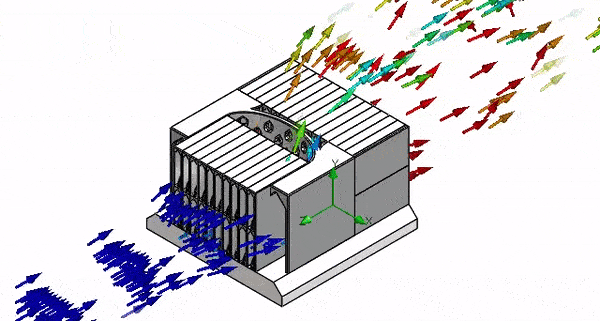3D printed Purdue heat sink wins competition
“The key to having high-performance electronic devices is keeping them cool,” said Soumya Bandyopadhyay, a Ph.D. student in mechanical engineering, studying heat transfer under Justin Weibel. “In the last decade or so, additive manufacturing has enabled us to come up with innovative designs for new advanced thermal solutions.”
These design innovations were put to the test as part of the Virtual Student Heat Sink Design Challenge, which gave university teams a theoretical heat source and dimensions, and challenged them to design a 3D printable heat sink that removed the most heat, for the lowest cost, with the minimum amount of materials. The competition was part of ITherm 2020, the Intersociety Conference on Thermal and Thermomechanical Phenomena in Electronic Systems, organized jointly between the American Society of Mechanical Engineers (ASME) K-16 Committee on Heat Transfer in Electronic Equipment, and the Institute of Electrical and Electronics Engineers (IEEE) Electronics Packaging Society, and sponsored by GE.
Purdue’s team began in January 2020, when in-person meetings were still an option. “We sat down and started brainstorming some ideas with pen and paper,” said Adeline Naon, a senior in mechanical engineering. “One of our contributing factors was drawing inspiration from the natural world, and that’s what led us to the shark skin design.”
Shark skin features microscopic teeth-like projections called denticles, designed to reduce drag in the water. Purdue researchers added these shapes onto the wall of their heat sink to reduce pressure drop and induce air mixing. They also added vortex generators, like those found on Formula 1 race cars, to intentionally swirl the air around to maximize the amount of heat transfer. These “swirlers” appear on both the front and rear of their heat sink design.
The next challenge was how to expel this newly heated air. Between the two swirlers, they designed a “respirator” section. Its geometry takes in cool air from the outside, and expels the heated air through a perforated ramp that resembles the air sacs found in human lungs. With the two “swirlers” and the “respirator” in the middle, the Purdue team felt they had a winning design.

But the COVID-19 pandemic presented an interesting wrinkle -- they couldn’t physically test their design. They relied on computer simulations to determine the success of the heat sink, before submitting their design to the judges. “The judges told us this was a very unique and smart solution,” said Saeel Pai, Ph.D. student in mechanical engineering. “None of the other teams in the competition utilized this design.”
The top six teams were chosen to have their designs 3D printed in aluminum by GE AddWorks on a GE Additive Concept Laser M2 machine. The physical heat sinks were then tested under identical conditions at Oregon State University, to determine if their real-world performance matched up with the simulations.
In the final results, Purdue’s heat sink outperformed the competition. “Its actual performance turned much better than any of us had thought,” said Bandyopadhyay. “Cost wise, it ended up saving much more. And it even did better in minimizing the amount of material used.”
While the pandemic prevented the team from celebrating their win in person, they are still pretty proud of their accomplishment. “Taking nature-inspired structures and translating them into something that can be 3D printed for a heat sink was very difficult,” said Julia Meyer, Ph.D. student under Partha Mukherjee. “It required a lot of re-thinking and optimizing of our design. But it was a fun process, and it resulted in something that I’m very proud of.”
“This heat sink represents what can be done when we think outside the box,” said Bandyopadhyay. “We all come from different backgrounds, and brought different ideas to the table. It really helped in the brainstorming process, to develop this idea into something that can be realized.”
Meyer also believes Purdue’s breadth of experience in heat transfer played a role in their win. “Having all the different kinds of research here,” she said, “you can just go downstairs, and there’s a whole other group of people you can collaborate with. That really allowed us to succeed.”
Writer: Jared Pike, jaredpike@purdue.edu, 765-496-0374
Source: Soumya Bandyopadhyay, bandyop0@purdue.edu
